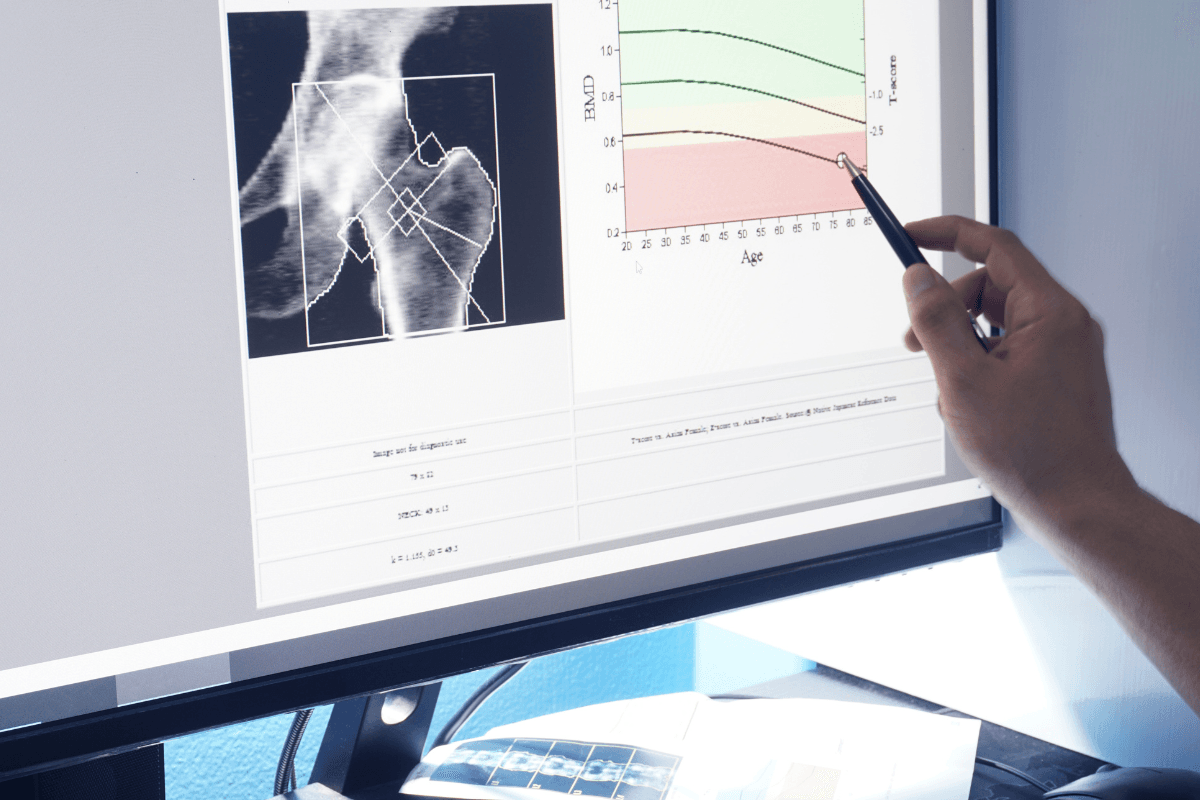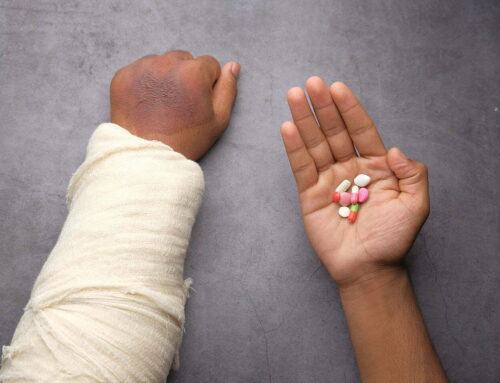
Healthy, strong bones form the foundation of an active life, helping to protect you from unexpected fractures that could threaten your mobility.
Breaking your wrist after a tumble down the slopes on a ski trip is one thing. Experiencing a fracture after an everyday activity or bumping into something is entirely another, and it’s a major red flag for osteoporosis.
Indeed, osteoporotic fractures occur every three seconds around the world, affecting nearly 9 million people per year.
As our bones naturally deteriorate and change with age, a bone density test is a valuable tool to help you evaluate your risk. Your T-score and Z-score are two numbers that can indicate whether you’re at risk for thinning bones and whether you should consider treatment.
Read on to learn more about what to expect during a bone density test and what these scores mean for your health.
Quick Takeaways:
- T-scores and Z-scores from a bone density test help determine your risk for osteoporosis and guide treatment decisions.
- A DEXA scan is the gold standard for accurately measuring bone density and spotting early bone loss.
- Lifestyle changes and targeted interventions like Marodyne LiV can make a significant impact on your bone health and fracture risk.
What is a Bone Density Test?
It might be helpful to think of your bones like a honeycomb. In your youth, this structure is dense and strong. As you get older, the holes within this honeycomb become larger, reducing the overall density and making your bones weaker and more brittle.

The honeycomb-like structure of healthy bone (left) becomes more porous and fragile in osteoporotic bone (right), reducing overall bone strength and increasing fracture risk.
But how do you know if you’ve lost too much bone? This is where the bone density test, T-scores, and Z-scores come in.
A bone density test, or bone mineral density test, is the only way to know for sure that you’ve lost too much bone mass. It’s a non-invasive scan that measures the strength of your bones. Your results are compared to two standards: the bone mass of a healthy young adult(your T-score) and the bone mass of your peers(your Z-score).
Decoding Your Bone Density Scores
After your bone density test, your results will be provided to you in the form of T-scores and Z-scores. While both numbers are important, they tell your doctor different things about your bone health.
What is a T-score?
A T-score is the primary number used to diagnose osteopenia (low bone mass) or osteoporosis. It compares your bone density to that of a healthy 30-year-old, the age when bones are typically at their peak mass.
The score is measured in standard deviations (SD).
- A T-score of 0 means your bone density is equal to that of a healthy young adult.
- A T-score between +1.0 and -1.0 is considered normal.
- A T-score between -1.0 and -2.5 indicates osteopenia, or low bone mass.
- A T-score of -2.5 or lower indicates osteoporosis.
Each one-point drop below 0 represents a 10-12% loss in bone density. For instance, a T-score of -2.0 means your bone density is about 20-24% lower than the ideal.
What is a Z-score?
While the T-score compares you to the peak standard, your Z-score compares your bone density to the average for someone of your same age, sex, and ethnicity.
A Z-score isn’t typically used to diagnose primary osteoporosis in postmenopausal women or men over 50. In these groups, low bone density is often an expected part of aging. However, a Z-score that is -2.0 or lower is considered “below the expected range for age” and may prompt your doctor to investigate further, as it could be a signal that something other than aging is causing bone loss (a condition known as secondary osteoporosis).
Osteoporosis is typically a disease that naturally occurs due to aging, genetics, or lifestyle habits that affect your bone density. It’s most common in women, affecting around 50% of females over 65 and one in four males over 65.
However, secondary osteoporosis can be found and is sometimes reversible. It can often stem from things such as:
- Inflammatory conditions
- Low production of reproductive hormones
- Malabsorption
- Blood conditions
- Endocrine conditions
- Abnormal bone structure
- Kidney disease/transplant
- Liver disease
- Vitamin D deficiency
For children, premenopausal women, and younger men, the Z-score is often a more valuable indicator than the T-score.
Concerned about your T-score? Learn how Marodyne LiV can help improve bone density naturally.
What to Expect During Your Bone Density Test
The gold standard for bone density testing is the DEXA scan (Dual-Energy X-ray Absorptiometry). It’s a simple, painless procedure that uses a very low dose of radiation, about one-tenth of what’s used for a standard chest X-ray.
You don’t need to do much to prepare. Your doctor may ask you to stop taking calcium supplements 24 to 48 hours before the test. You should also avoid wearing clothing with metal zippers, buttons, or buckles.
During the scan, you’ll lie motionless on your back on a padded table as a mechanical arm passes over your body. The test usually focuses on the hip and spine, as these are common sites for fractures. The entire process is quick, often taking less than 15 minutes.

Your DEXA scan results will include images of your bones and graphs showing how your T-scores compare to healthy bone density standards.
What to Do After Your Bone Density Test
Receiving your bone density scores is the beginning of an important conversation with your doctor. Here are some suggestions of what to do next:
- Discuss the Results with Your Doctor: Talk through what your T-score and Z-score mean for you specifically. Your doctor will consider these scores along with other risk factors to create a complete picture of your bone health.
- Evaluate Your Lifestyle: Your doctor will likely recommend lifestyle changes. This includes ensuring you get enough calcium and vitamin D, performing regular weight-bearing exercises, and quitting smoking or reducing alcohol intake.
- Create a Treatment Plan: If you have osteoporosis, your plan may include medication. If you have osteopenia, your focus will be on prevention. Discuss all options, including non-drug therapies that can help stimulate bone growth.
- Schedule a Follow-Up: Your doctor will recommend when you should have your next DEXA scan to monitor any changes in your bone density. This is typically every one to two years.

The Marodyne LiV device uses low-intensity vibration technology to naturally stimulate bone growth in just 10 minutes per day.
Improving Bone Density at Home
Receiving a low T-score can be disheartening, but it’s not the end of the story. Many individuals have successfully taken action to improve their bone density.
Physical therapist Margaret Martin reviews how the Marodyne LiV device works and its potential benefits for bone health:
Marodyne LiV (Low-Intensity Vibration) is an advanced, clinically proven solution designed to support people suffering from bone density loss, whether that’s due to osteoporosis or osteopenia. It’s a certified medical device that provides a non-invasive, drug-free treatment to maintain and improve bone health.
By standing on the device for just ten minutes a day, users receive gentle mechanical stimulation that’s equivalent to the impact of running 19 kilometers, a process that improves bone density, muscle strength, coordination, balance, and overall musculoskeletal health.
With over 35 years of research backing its design (check out the fascinating history here), Marodyne is especially well-suited for adults at risk of bone density loss, seniors worried about falls, and even people who are just seeking alternative solutions to pharmaceuticals.
Easy to use and integrate into your daily routine (allowing you to enjoy other activities like watching TV during treatment), it’s equal parts convenient and empowering.
Madeline, a Marodyne user from the United States, shares her results:
"I have been using the LiV low-intensity vibration plate for about a year now, and this week I had my follow-up DEXA exam. I wanted to let you know that my bone density statistics have increased significantly since my last exam in 2012! My overall T-score is -2.4, and the bone density in the lumbar spine has increased by 6.5%, and in the right femur, it has increased by 8.3%."
Learn more about how the Marodyne LiV treatment works today.
FAQs About Bone Density Testing
Who should get a bone density test?
Bone density tests are recommended for women over 65, men over 70, and individuals with risk factors like family history, previous fractures, certain medications, or health conditions that affect bone health. If you're unsure whether you should be tested, speak with your doctor about your personal risk factors.
How often should bone density be tested?
Most people at risk should have a DEXA scan every two years, but your doctor will advise the right interval based on your individual health profile and results.
Can bone density improve over time?
Yes, with proper nutrition, regular weight-bearing exercise, and in some cases, medication or targeted therapies like low-intensity vibration technology, it is possible to slow bone loss or even improve bone density.
What should I do if I have osteopenia (low bone mass)?
Osteopenia is a warning sign, not a diagnosis of osteoporosis. Focus on prevention through calcium and vitamin D supplementation and weight-bearing exercise, and consider non-pharmaceutical interventions like the Marodyne LiV device to help maintain and build bone density before it progresses.
Are bone density medications the only treatment option?
No. While medications can be effective, they often come with side effects. Many people successfully improve their bone health through lifestyle changes, targeted exercise, proper nutrition, and non-drug therapies like low-intensity vibration technology.
Take Control of Your Bone Health
More than 2.3 million Canadians are living with osteoporosis, but bone health doesn't have to decline with age. While genetics play a role, you have real power to strengthen your bones and protect your mobility and independence.
The Marodyne LiV device brings NASA-inspired technology into your home. Originally developed to help astronauts combat bone loss in zero gravity, this low-intensity vibration platform now offers a safe, drug-free way to stimulate natural bone growth. Just 10 minutes a day helps build bone and muscle strength, improve balance and circulation, and support your long-term musculoskeletal health.
Your bones are worth the investment. Early action today means stronger bones, better balance, and greater confidence in your movement tomorrow.




 Black Friday → Christmas Sale! Save $300 + Free Shipping
Black Friday → Christmas Sale! Save $300 + Free Shipping 